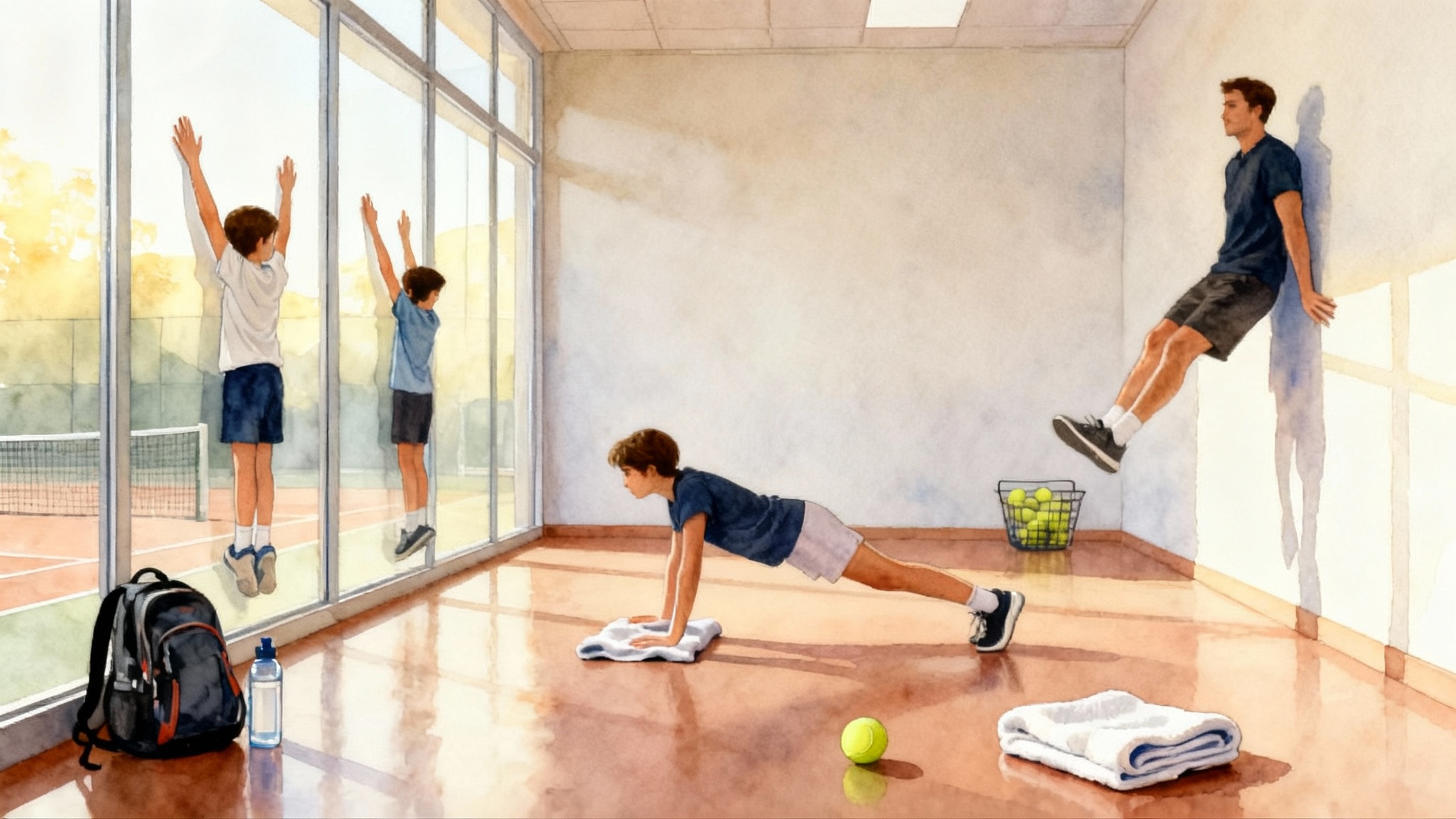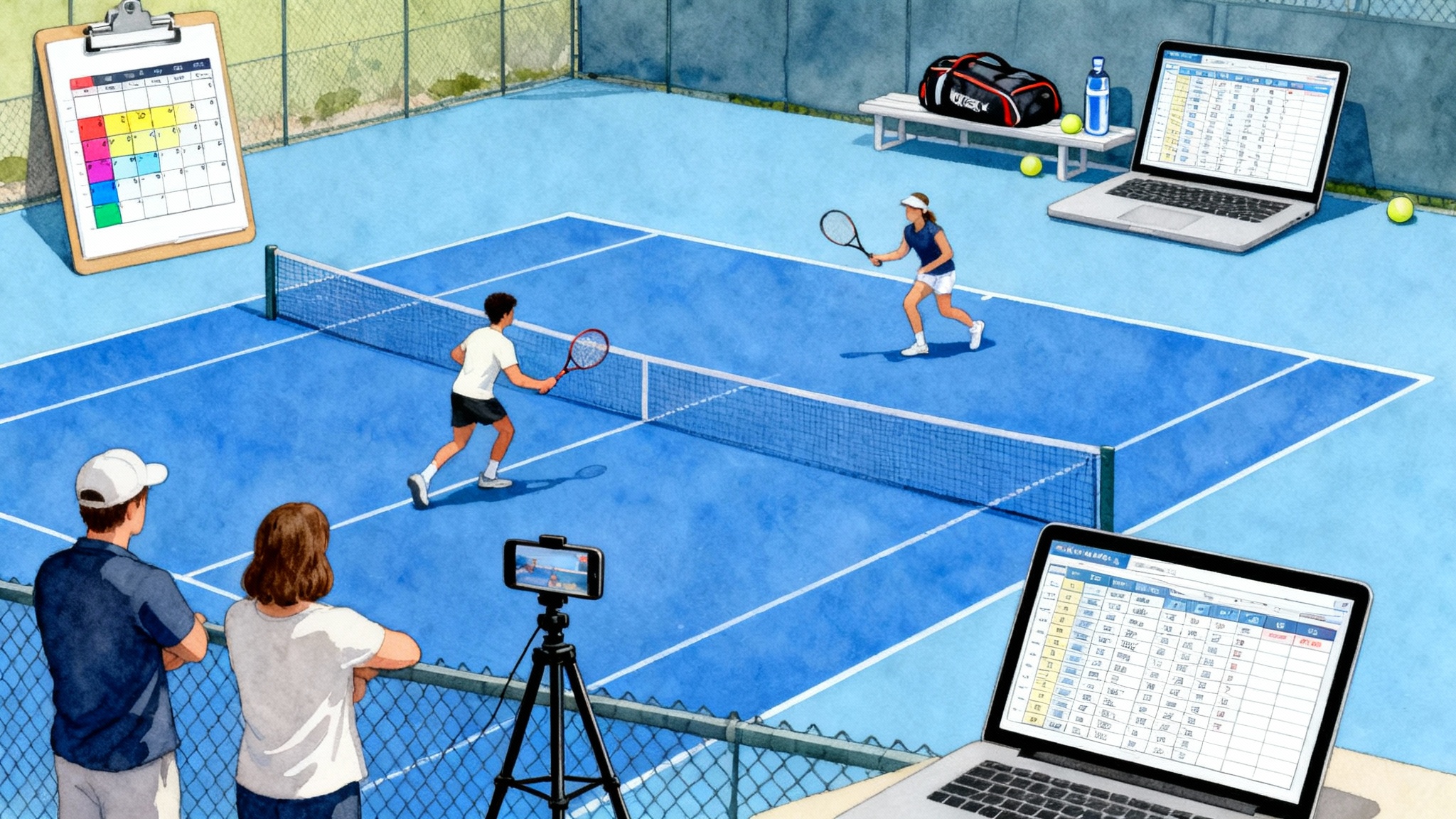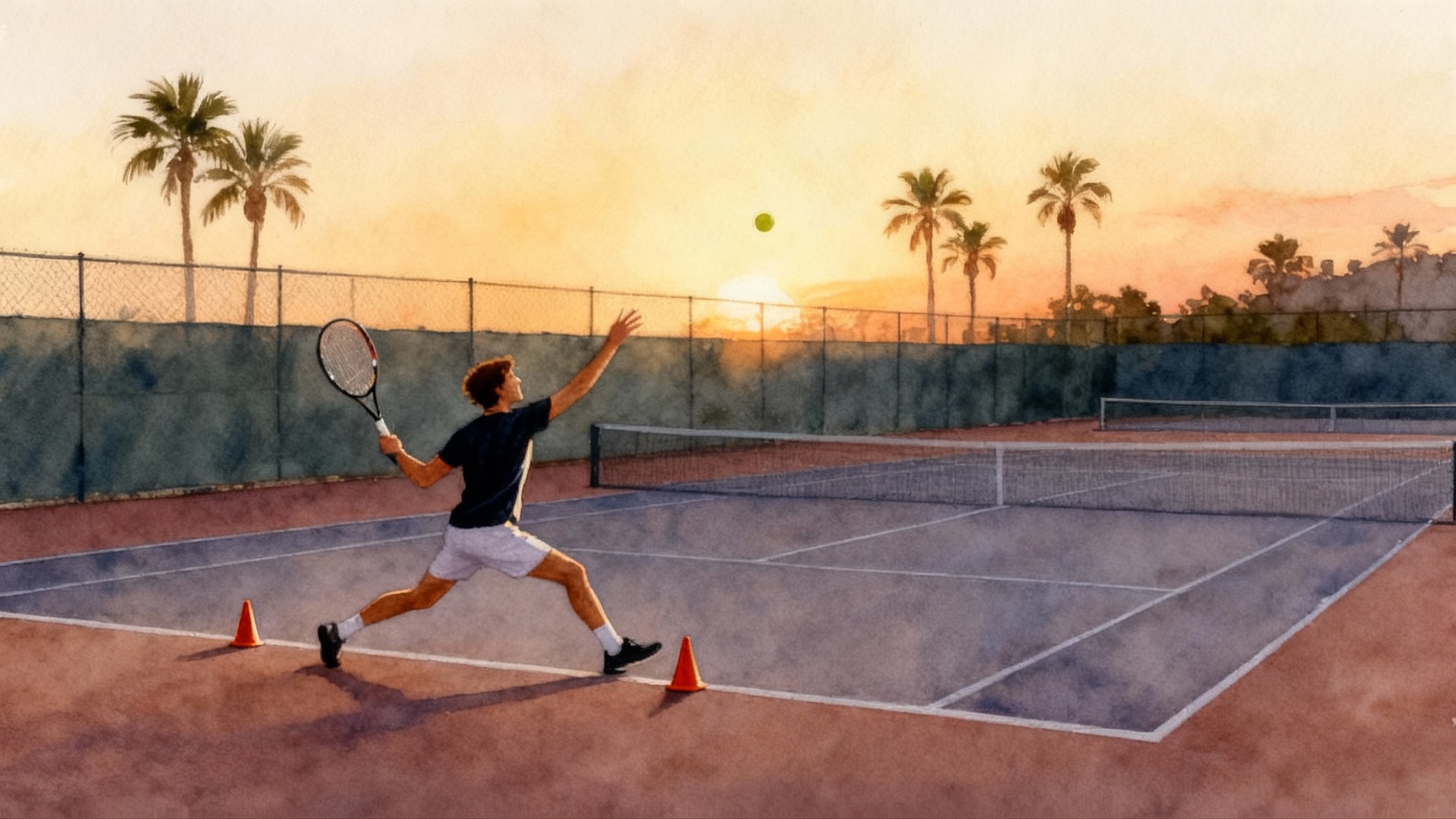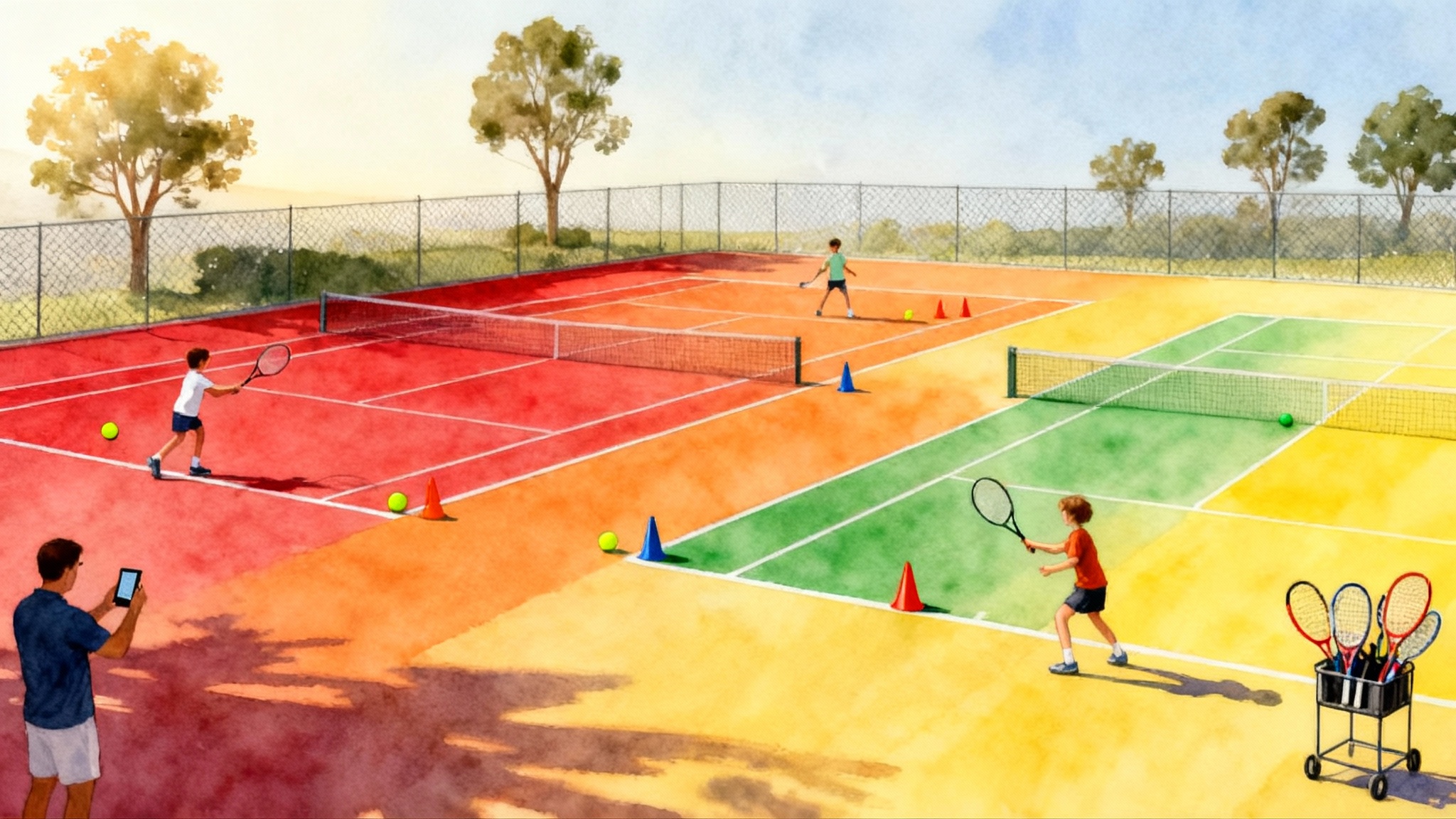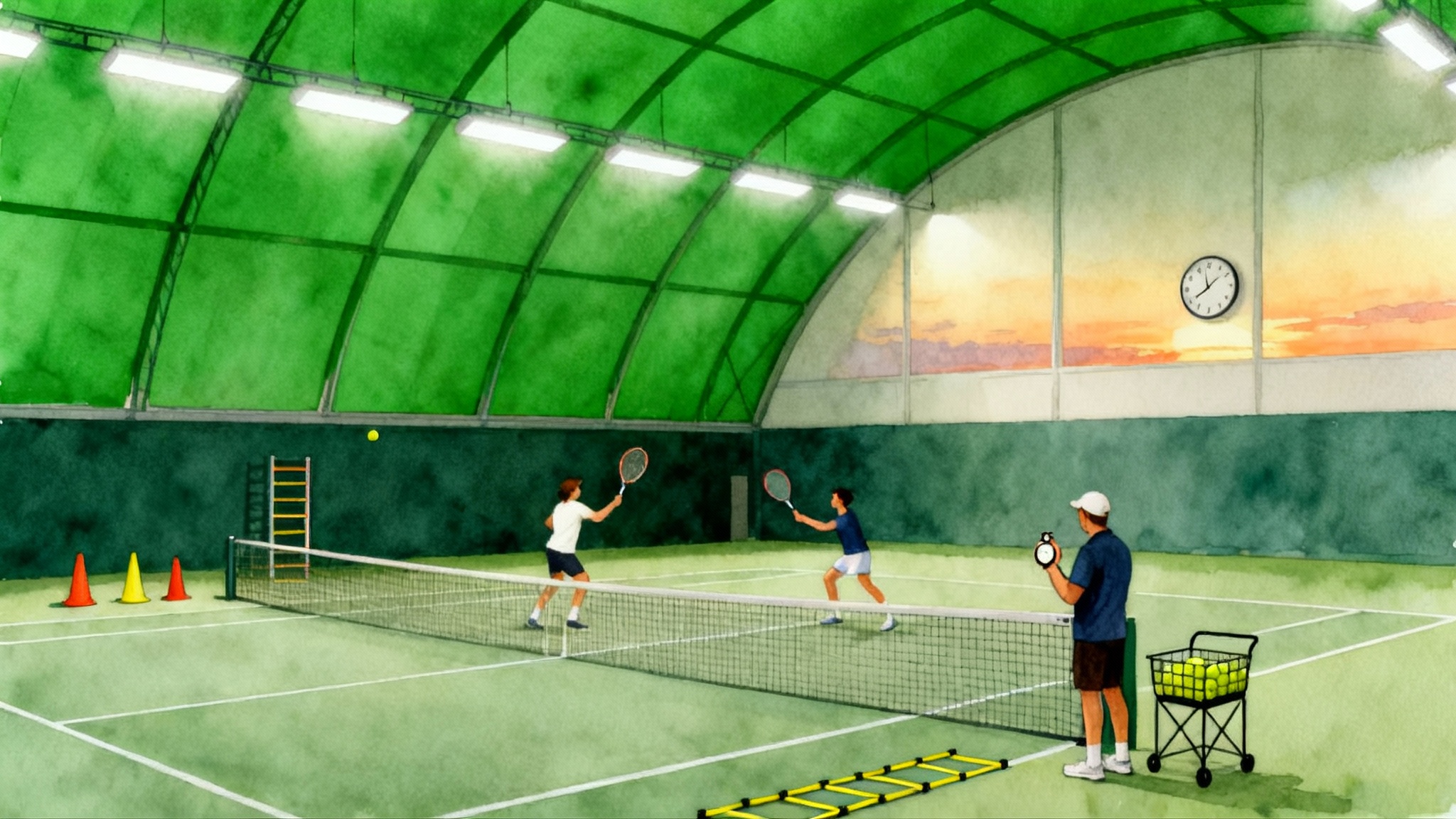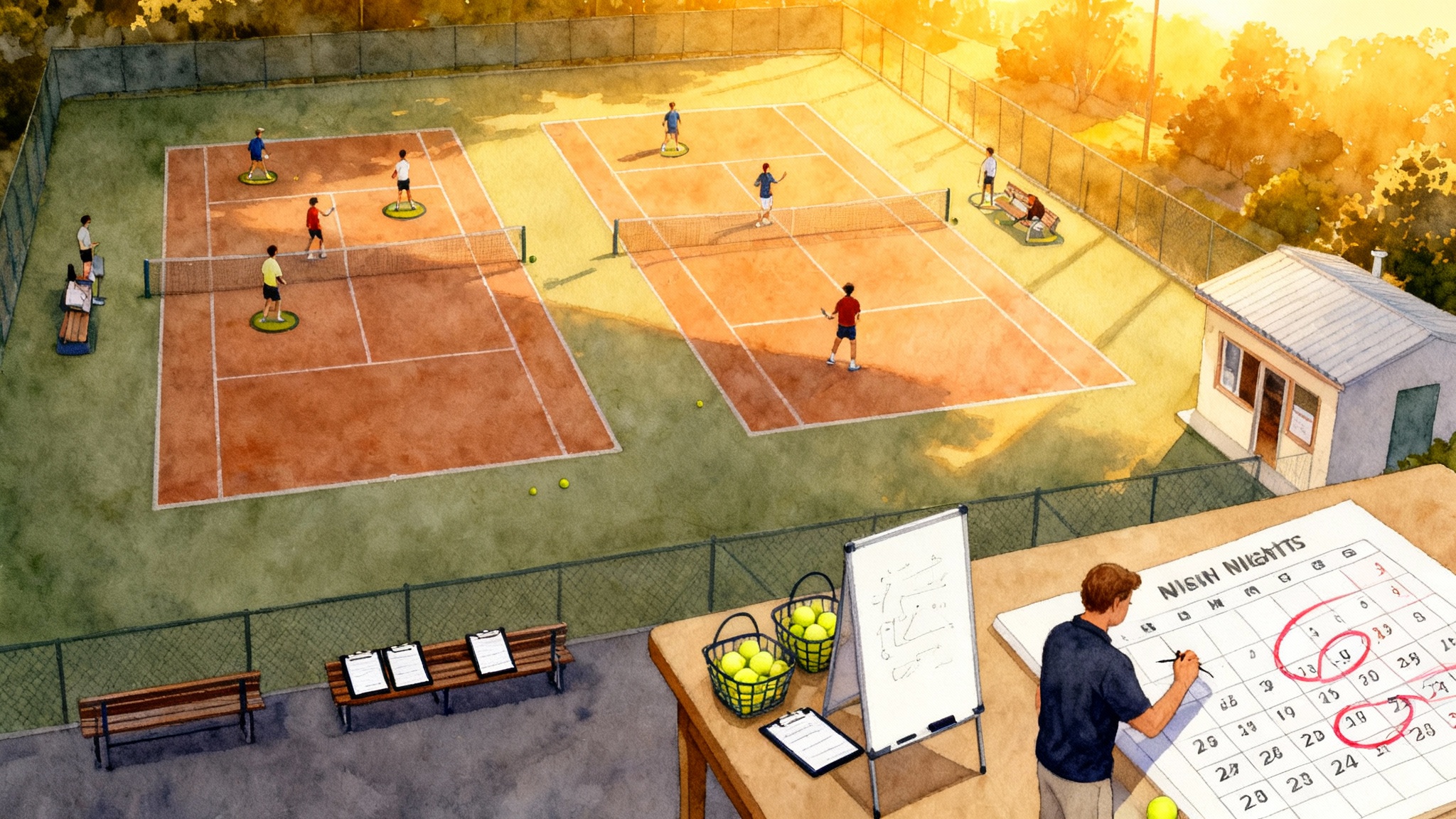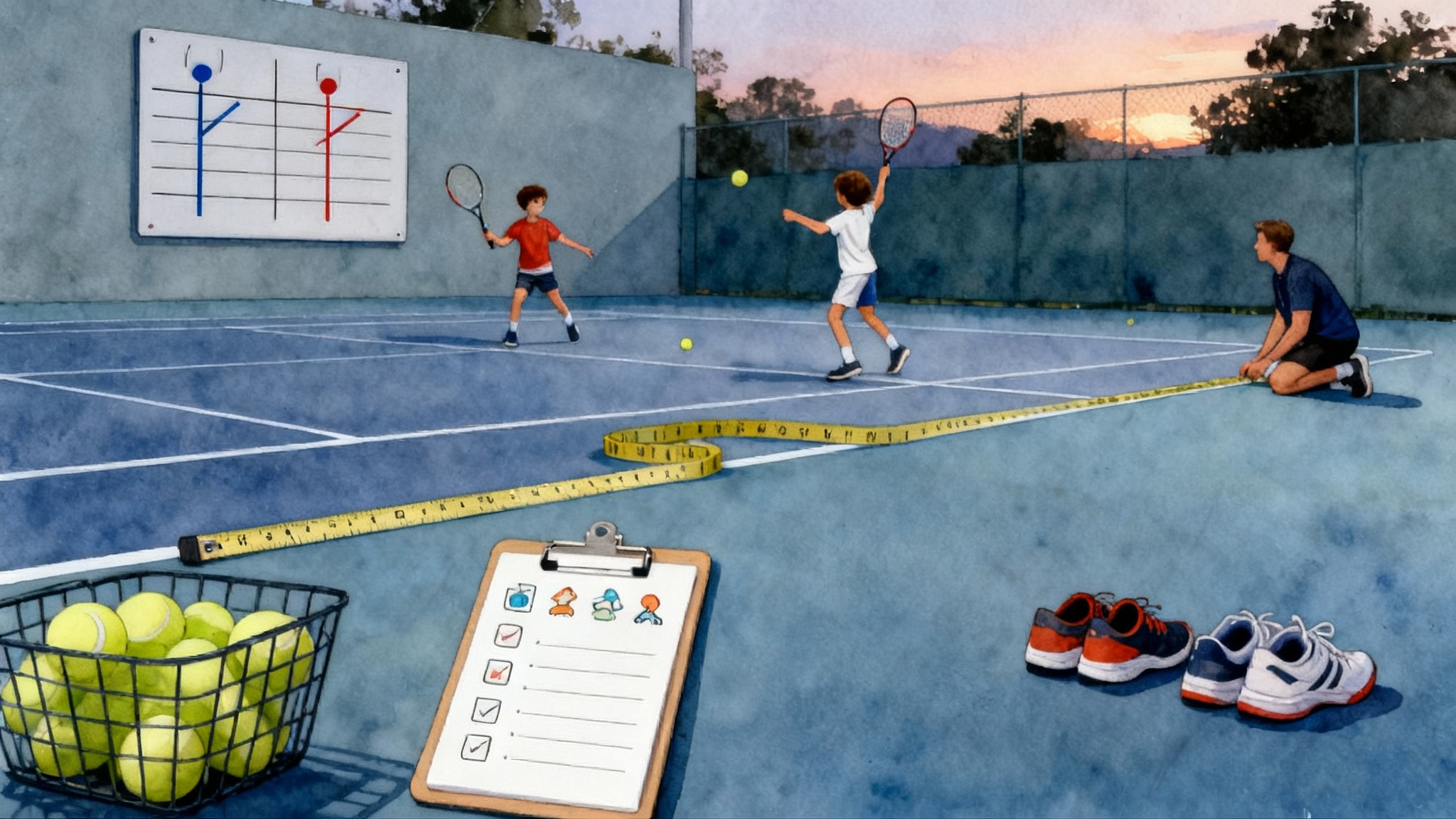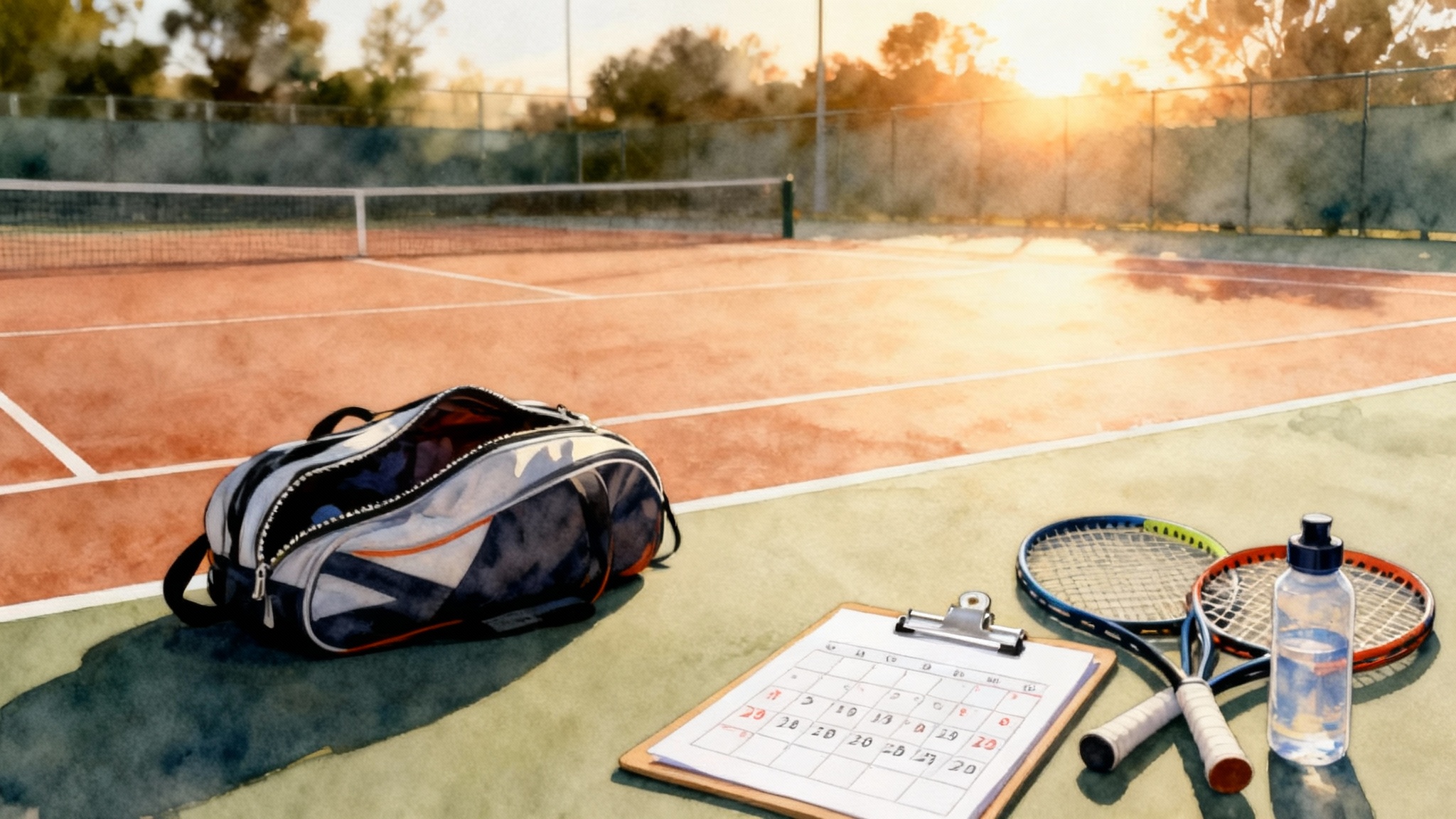Off-Season Tennis 2025-26: 12-Week Base Build for All Ages
A practical 12-week winter plan to rebuild fitness, sharpen technique with easy video checkpoints, and dose match play smartly. Age-banded templates, at-home gear, and a December–February example from Tenacity Tennis Academy.
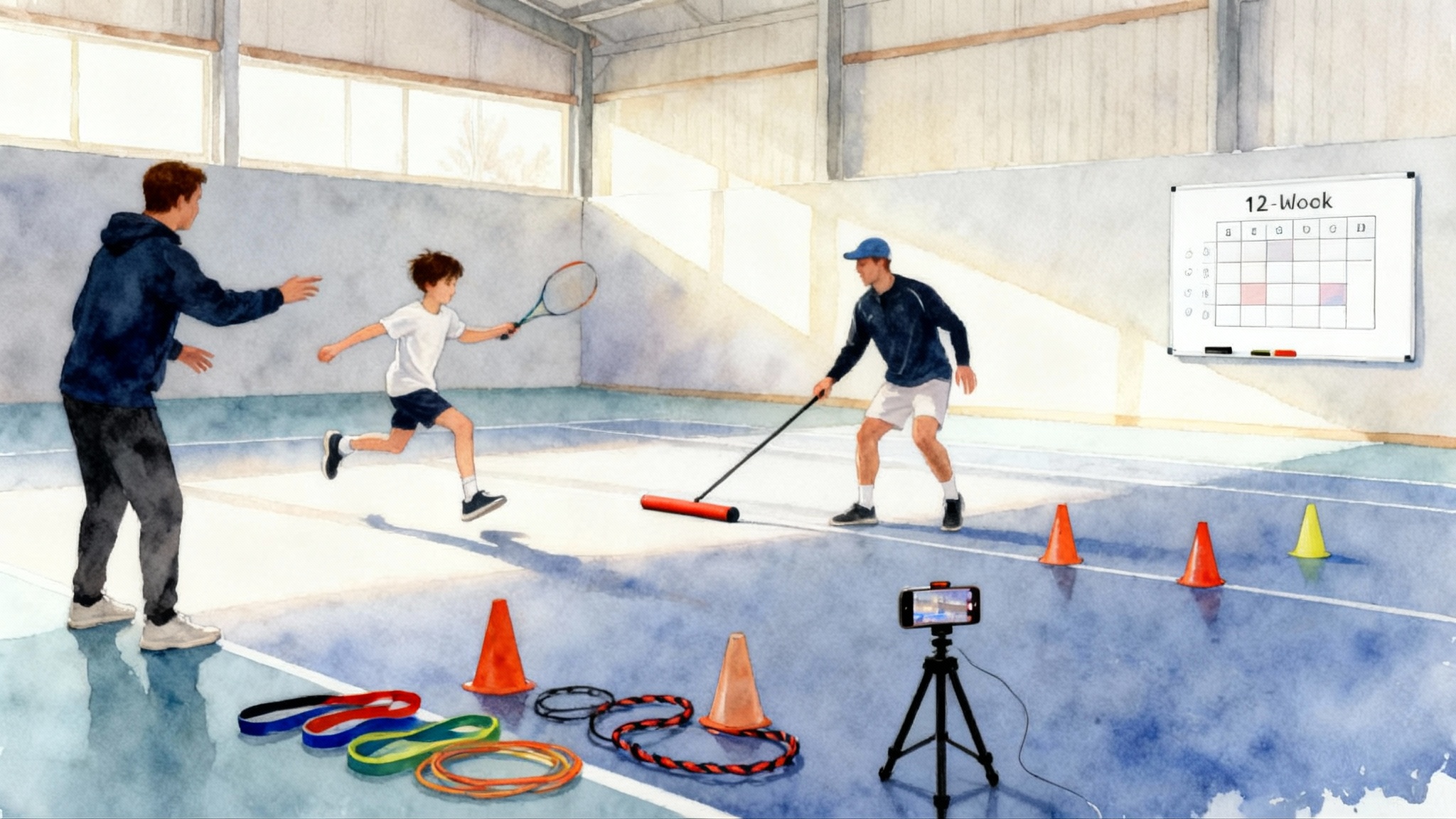
Why a winter base build wins your spring
The off season is your clean slate. Tournaments slow down, school schedules stabilize, and courts are quieter. That makes December to February the window to rebuild the parts that sprint-heavy match weeks erode: strength, deceleration, mobility, and your aerobic base. When those basics improve, technique sticks faster and match play becomes less streaky.
This 12-week plan does three things well:
- Rebuilds movement capacity with strength, deceleration, mobility, and aerobic base work.
- Sharpens key skills using simple, repeatable video checkpoints.
- Doses match play in smart amounts so fitness gains are not drowned out by fatigue.
You will get age-banded weekly templates, a minimal at-home gear list, and a concrete look at how Tenacity Tennis Academy runs its December to February blocks so you can mirror the flow.
How this plan is structured
- Duration: 12 weeks, from early December to late February.
- Mesocycles: three blocks of four weeks each.
- Block 1 weeks 1 to 4: Technique rebuild and aerobic base.
- Block 2 weeks 5 to 8: Strength and deceleration emphasis with moderate match play.
- Block 3 weeks 9 to 12: Tennis-specific speed, targeting, and match rehearsal.
- Microcycle rhythm: two to three focused training days, one lighter recovery day, then one match or match-like day. Repeat.
If you already train four or more days per week, you will redistribute rather than add. If you train two days per week, you will make those days count with the templates below.
The fitness pillars and how to train them
Aerobic base that supports tennis
Tennis points are intense but brief. The aerobic system still matters because it refuels those bursts and keeps you fresh between points. During the base phase, use steady work at a conversational effort for 30 to 45 minutes, two to three times per week. The International Tennis Federation outlines endurance options for tennis, including extensive continuous sessions in the aerobic range that build the foundation for later intensity. See the ITF guide to ITF tennis endurance training.
Practical choices:
- Court rally sets: 10 to 12 minutes of cooperative crosscourt with a change of direction every 3 balls, twice per session.
- Off court: brisk uphill walk, easy jog, spin bike, or jump rope in intervals like 8 by 2 minutes easy with 1 minute light recovery.
Effort guide: Rate of Perceived Exertion 4 to 5 on the 0 to 10 scale, where conversation is possible.
Strength that protects and produces
We want joint-friendly strength that carries to movement. Focus on patterns, not numbers.
- Lower body: split squat, lateral lunge, hinge pattern, calf raises.
- Upper body and trunk: push up variations, one-arm row, half-kneeling press, anti-rotation core work like pallof press and dead bug.
- Eccentric time under tension: use 4 to 5 seconds on the lowering phase in at least one set per exercise to build tendon and deceleration capacity.
Sets and reps: two to three sets of 6 to 10 reps for main lifts, three times per week in Blocks 1 and 2. In Block 3, keep two sessions with lighter loads and more speed of movement.
Deceleration, your on-court brakes
Injuries cluster when players cannot stop under control. Build braking skill weekly.
- Lateral decel to stick: shuffle 3 to 4 meters, plant outside foot under hip, stick for 2 seconds, and reset. Three by six reps per side.
- Forward to backpedal brake: sprint 5 meters, drop hips to stop within one step, back out under control. Three by five reps.
- Low hop landings: small depth drops from a 6 to 8 inch box, land softly, knees track over mid foot, hold for 2 seconds. Two by six reps.
Pair decel with your strength day. Start slow and crisp. Speed comes after clean mechanics.
Mobility that holds technique together
Ten minutes daily beats one hour weekly. Hit these zones:
- Ankles: knee-to-wall dorsiflexion, 2 by 8 slow reps per side.
- Hips: 90-90 hip switches, couch stretch, and lateral lunge rocks, one minute each.
- Thoracic spine: open books and quadruped rotations, 2 by 6 per side.
- Shoulders: sleeper stretch light, wall slides, and band pull aparts, 2 by 12.
Place mobility after a short warm up or at day’s end.
A simple way to control intensity
You do not need a heart rate strap to stay in the right zone. Use the 0 to 10 Rate of Perceived Exertion scale. See the Cleveland Clinic’s RPE scale basics. Aim for RPE 4 to 5 for aerobic base, RPE 6 to 7 for hard tennis-specific intervals, and keep most technical drilling at RPE 3 to 4. For serve and return sessions, pair this plan with deeper work on return patterns and timing.
Video checkpoints: fast feedback with a phone
Film twice per block, in Weeks 2, 6, and 11. Use a smartphone at 60 frames per second if possible.
Set up:
- Back view: camera at baseline center, chest height, two meters behind the fence.
- Side view: camera on your backhand side, even with the baseline, chest height.
- Record 8 serves, 8 forehands, 8 backhands. Rally feeds are fine.
Checklists to keep it simple:
Serve green flags:
- Toss peaks slightly in front of the front foot, not behind the head.
- Back hip leads forward as the racquet drops, not the upper back arching.
- Contact arm fully extended with racquet edge on just before contact.
Serve red flags:
- Toss drifts left or right more than one racquet head.
- Knee bend without hip drive, producing a backbend rather than an upward push.
- Contact well behind the front foot.
Forehand green flags:
- Unit turn shows strings to the side fence, racquet hand relaxed.
- Contact lined up in front of the lead hip.
- Finish over shoulder with balance on the outside edge of the front foot.
Forehand red flags:
- No turn before the step, arms only swing.
- Contact too close to the body.
- Falling away on contact instead of bracing.
Backhand two hand green flags:
- Hips load into outside leg before the step.
- Contact in front of the lead hip with level shoulders.
- Off hand drives through, not yanking up early.
Backhand red flags:
- Late set, racquet still traveling back as the ball arrives.
- Collapse at the front knee.
- Off hand quitting early, producing a slap.
Use the video to pick one technical focus per block. Layering three changes at once rarely sticks.
Smart match play dosing
The goal is to preserve energy for quality training while keeping your competitive rhythm.
- Block 1 weeks 1 to 4: one match set per week or a two hour practice with 6 to 8 point play segments. RPE 6 peaks, but most work at RPE 4 to 5.
- Block 2 weeks 5 to 8: one full match every other week, otherwise two short play blocks of 20 to 30 minutes in practice.
- Block 3 weeks 9 to 12: one full match weekly, plus targeted serve and return games.
Short options when time is tight:
- Two 15 minute tiebreak blocks with a partner.
- Serve plus one pattern games first to 11 points.
Pair serve and return work with this guide to return patterns and timing.
Age-banded weekly templates
All templates include a general warm up of 8 to 10 minutes of dynamic moves. Static stretching stays after practice.
Juniors age 10 to 13
- Monday: Strength and mobility 40 minutes
- Split squat 3 by 8, push ups 3 by submax, band row 3 by 12, dead bug 3 by 8 per side.
- Mobility 10 minutes.
- Wednesday: Aerobic base 30 minutes
- Jump rope 6 by 2 minutes, rally jogging drills, or uphill walk, RPE 4 to 5.
- Friday: On court skills 60 minutes
- 20 minutes cooperative crosscourt, 20 minutes serve targets to deuce and ad, 20 minutes approach and first volley.
- Weekend: Play dose 60 to 90 minutes
- One set to 6, then two tiebreaks. Finish with 10 minutes easy rally cool down.
Progression: Add one set on Friday in Weeks 5 and 9, make strength eccentrics 4 second lowers in Weeks 5 to 8.
Juniors age 14 to 18
- Monday: Strength and deceleration 60 minutes
- Lateral lunge 3 by 6 per side, Romanian deadlift pattern 3 by 8, single leg bridge 3 by 10, low hop landings 2 by 6, lateral decel to stick 3 by 6.
- Tuesday: On court aerobic base 45 minutes
- 3 by 10 minute cooperative rally blocks with pattern changes every 3 balls, RPE 4 to 5.
- Thursday: Technique and patterns 75 minutes
- Serve plus one patterns, crosscourt to down the line change, return plus first ball.
- Saturday: Match play or match like 90 to 120 minutes
- Full match every other week, otherwise four 15 minute live ball segments and two 10 point tiebreaks.
Progression: In Block 3, shorten strength to two sets and add 10 by 10 seconds on, 20 seconds off point simulation sprints at the end of Tuesday.
Adults age 19 to 39
- Tuesday: Strength 50 minutes
- Split squat 3 by 6 per side with 4 second lowers, one arm row 3 by 10, push up 3 by submax, pallof press 3 by 12.
- Thursday: On court drills 60 minutes
- 15 minutes rhythm rally, 20 minutes serve targets, 15 minutes approach and finish, 10 minutes doubles return work.
- Saturday: Play dose 90 to 120 minutes
- Singles or doubles. Keep the second hour lighter if you feel RPE 8 spikes.
Progression: Add a 30 minute Zone 2 session Sunday or Wednesday in Weeks 3 and 7.
Adults age 40 plus
- Monday: Mobility and strength 45 minutes
- Longer warm up, ankle and hip mobility, then goblet squat 2 by 8, hinge pattern 2 by 10, incline push up 2 by 10, band row 2 by 12.
- Wednesday: Aerobic base 35 minutes
- Uphill walk or easy bike, RPE 4 to 5.
- Friday: On court technique 60 minutes
- Serve rhythm, return blocks, and volley touch. Stop while you still feel smooth.
- Weekend: Doubles play 90 minutes
- Prioritize positioning and serves. Cut the session if joints feel achy above a 3 out of 10.
Progression: Keep strength loads modest. Add one extra mobility session on Saturday night if you play Sunday morning.
Busy parent two day fallback
- Day 1: 30 minute strength and mobility plus 20 minute on court serve and return.
- Day 2: 40 minute on court rally and pattern work plus 20 minute aerobic base walk.
This keeps the wheels turning during the heaviest weeks at work or school.
The at home gear kit
You do not need a gym. This kit fits in a tote and costs less than a typical racquet upgrade.
- Mini bands and a light long resistance band.
- Jump rope.
- Sliders or paper plates for core and lunge variations.
- A 6 to 8 pound medicine ball or a sturdy basketball for wall throws outside.
- Foam roller and a lacrosse ball for soft tissue work.
- Optional adjustable dumbbells. If not, use filled water jugs or a backpack.
Retailers like Decathlon, Perform Better, and local sporting goods stores all carry these basics. Pick function over brand.
Tenacity Tennis Academy December to February example
Below is a representative winter block that Tenacity Tennis Academy uses to guide juniors and adult competitors. The numbers give you the proportions to mirror, not a rigid script.
- December weeks 1 to 4, Base and rebuild
- Theme: volume of quality touches, low intensity.
- Weekly mix: 40 percent on court technical drilling, 30 percent aerobic base, 20 percent strength and mobility, 10 percent match play.
- Benchmarks: film serve and groundstrokes in Week 2; 12 minute aerobic test in Week 4.
- January weeks 5 to 8, Strength and brakes
- Theme: force absorption and controlled speed.
- Weekly mix: 30 percent on court drilling, 30 percent strength with eccentric focus, 20 percent deceleration and plyometric skill, 20 percent match play.
- Benchmarks: Week 6 video check, Week 7 deceleration stick test, Week 8 deload with reduced volume by about 30 percent.
- February weeks 9 to 12, Sharpen and rehearse
- Theme: tennis-specific speed and tactical rehearsal.
- Weekly mix: 40 percent on court competitive drilling, 20 percent strength maintenance, 20 percent high quality serves and returns, 20 percent match play.
- Benchmarks: Week 11 video check; Week 12 repeat Week 4 tests and compare improvements.
How they teach deceleration in January:
- Every strength day starts with five minutes of landing mechanics and lateral stick drills.
- Players count and log two clean sticks per side per rep, then progress speed only when the ratio of clean sticks exceeds 80 percent.
How they dose match play:
- No back to back full matches until Block 3.
- Juniors play one full match every other week in Block 2; adults alternate singles with doubles to manage joint load.
Warm up and cool down, the underrated bookends
Before practice: five to eight minutes of dynamic movement like jogging with arm circles, lateral shuffles, lunges with reach, and inchworms. After practice: walk until breathing is calm, then perform static stretches for hips and shoulders. USTA Player Development favors dynamic warm ups before hitting and static stretching after, which matches what you will feel works in real sessions. For durability, review age specific shoulder and elbow care.
Cool down add on: two minutes of diaphragmatic breathing lying on your back with feet on a chair to reduce post session tension.
Checkpoint tests and targets
Run these at Weeks 1, 4, 8, and 12. Keep the same court and time of day if possible.
- 12 minute distance test: aim for a 5 to 10 percent increase by Week 12.
- 5 10 5 shuttle: from Week 1 to Week 12, shave 0.2 to 0.4 seconds for most juniors and 0.1 to 0.3 for adults.
- Serve accuracy: 40 balls to four targets, record makes. Improve by 20 percent in Block 1, then hold while adding speed.
- Rally quality: two five minute cooperative rallies per side, count balls in. Strive for a 15 to 25 percent bump by Week 8, then maintain under mild pressure in Block 3.
If a metric stalls for two weeks, reduce match volume by 20 percent for seven days and put energy into the limiting pillar. Then retest.
A week by week flyover
- Week 1: Baseline tests, light strength, and easy aerobic. Film if time allows.
- Week 2: Technique focus 1. Two strength sessions, one aerobic base, one play dose.
- Week 3: Repeat Week 2 and add decel primers.
- Week 4: Retest, debrief, and a lighter play dose.
- Week 5: Strength and decel emphasis. Serve plus one patterns return.
- Week 6: Video session 2. Shift aerobic base to on court rallies.
- Week 7: Slightly heavier strength, match play every other week.
- Week 8: Deload at 70 percent of normal volume. Maintain rhythm, not load.
- Week 9: Re accelerate with tennis-specific speed and shorter work to rest intervals.
- Week 10: Match rehearsal week. One full match, one targeted serve and return session.
- Week 11: Video session 3 and sharpen patterns you will use most.
- Week 12: Final tests, one match, and a two day taper for those with events in early March.
How to adapt when life intervenes
- Protect the two most valuable sessions: one strength and decel day, and one on court technique day with serves.
- Convert aerobic base to errands: brisk uphill walk during a call, or 15 minutes of jump rope spread across the day.
- Use micro sessions: three 10 minute blocks spaced out can replace a missed hour.
If soreness spikes above 3 out of 10 for more than two days, cut eccentric loading in half for a week and keep match play short.
Common pitfalls and their fixes
- Too much match play in January: fitness gains stall. Fix by capping to one full match every other week until Block 3.
- Skipping video: technique changes drift. Fix by scheduling 15 minutes at the end of a hitting session in Weeks 2, 6, and 11.
- Only lifting concentric and fast: braking lags. Fix by keeping one slow lowering set per main lift all the way through Week 8.
Your starting line
Pick a start date and build around real life. For most readers in the United States, a practical window is Monday December 1, 2025 through Sunday February 22, 2026. Put your filming days, strength days, and match days on the calendar now. Keep the plan simple, keep the dials steady, and let the mix of aerobic base, strength, deceleration, and targeted technique work do the quiet heavy lifting. When spring matches arrive, the difference shows up in the third set and on the next morning when you wake up ready to do it again.
